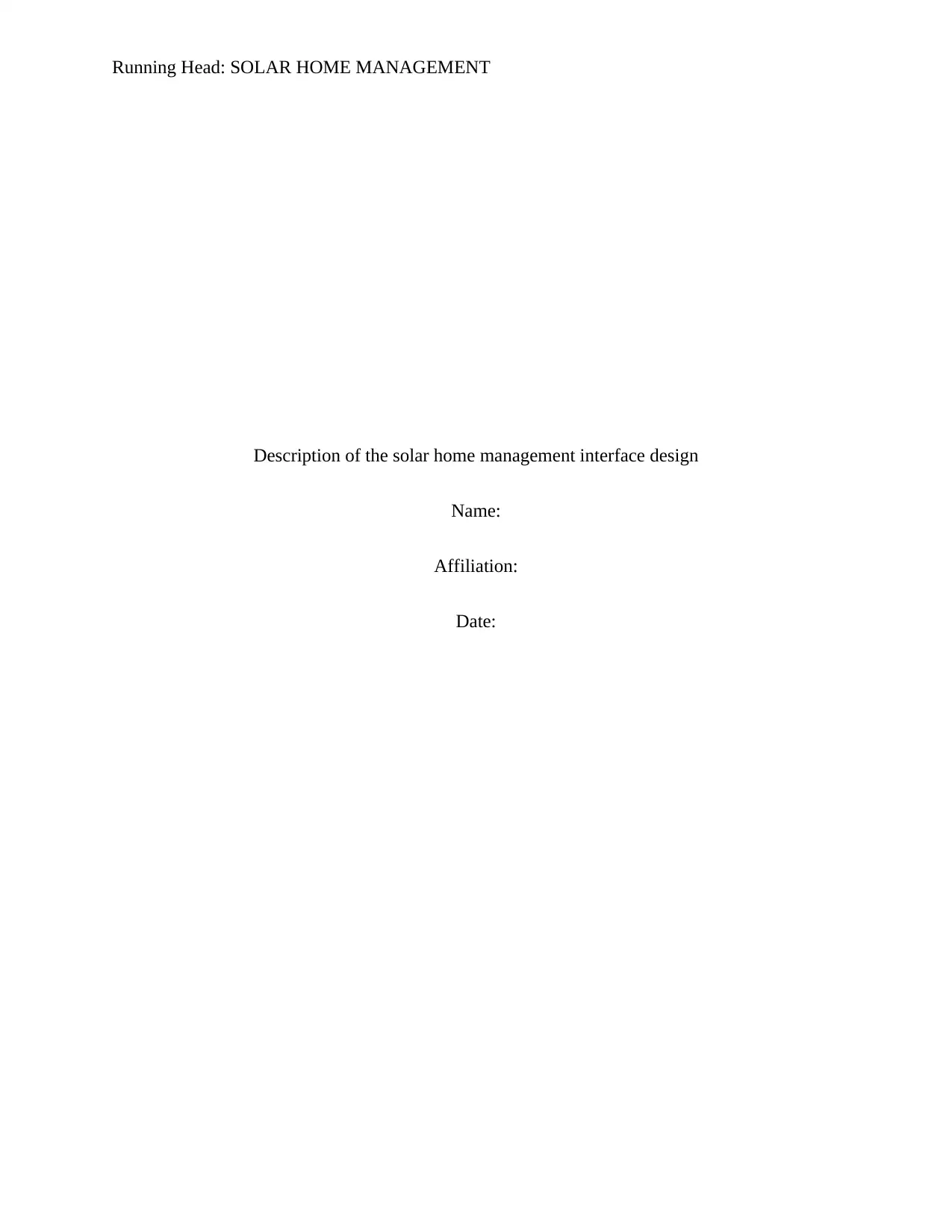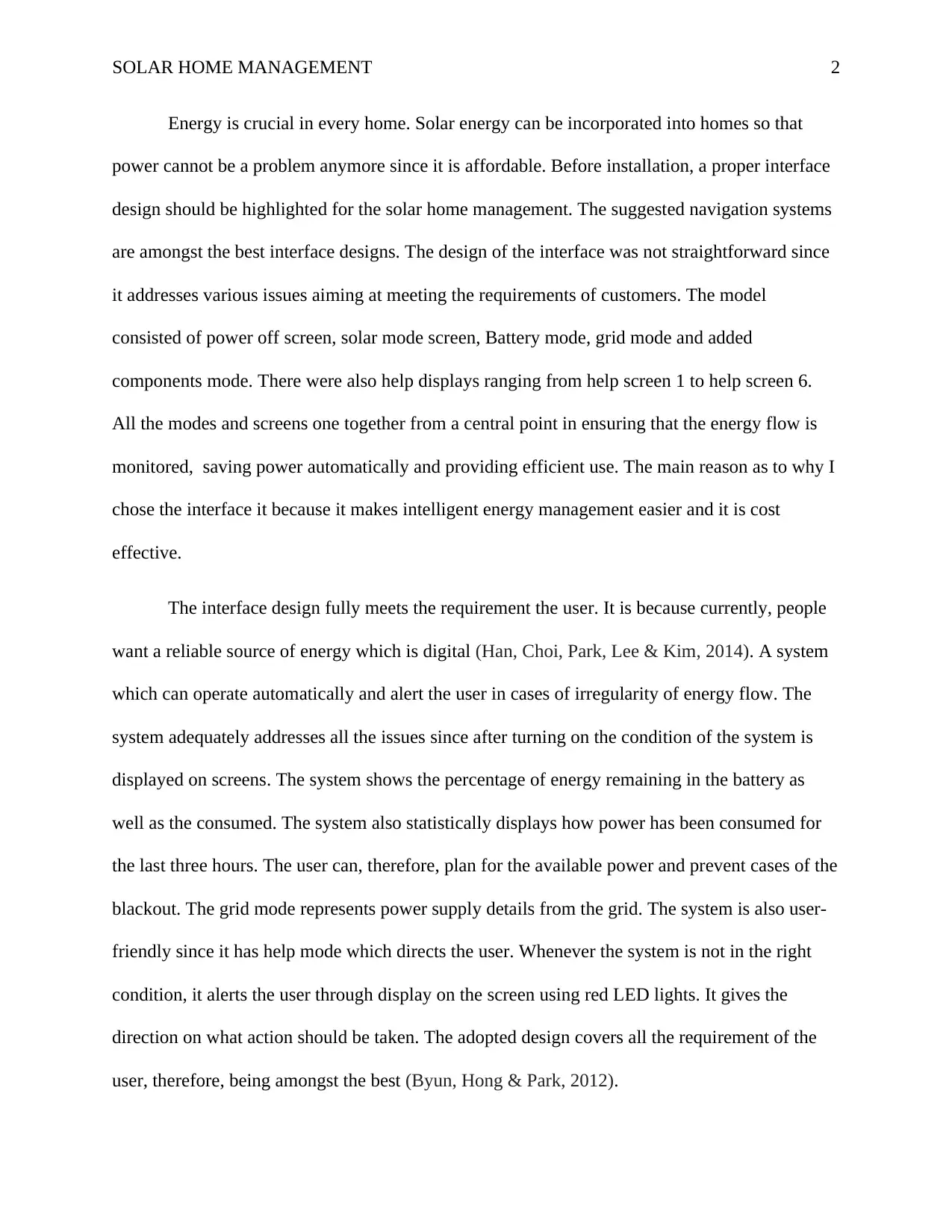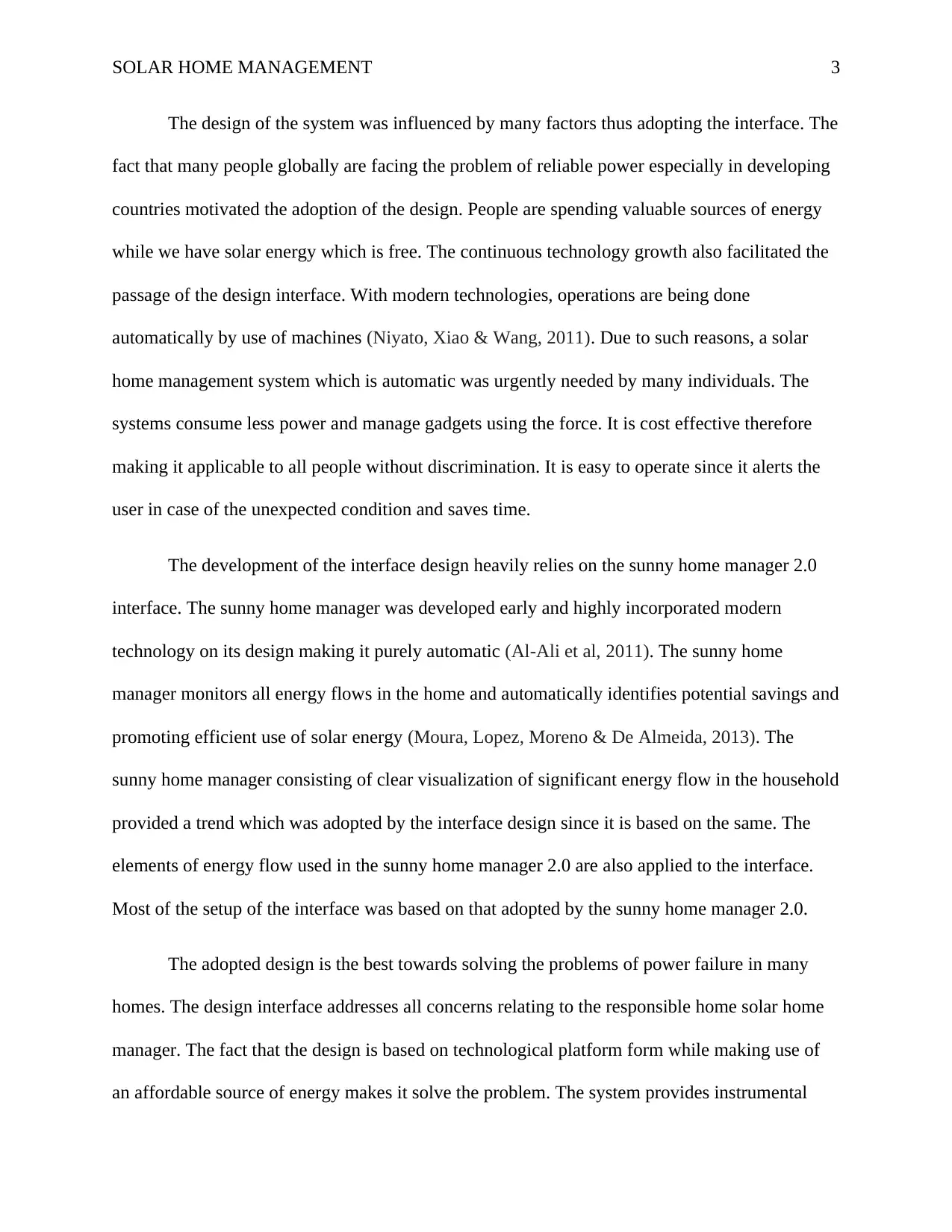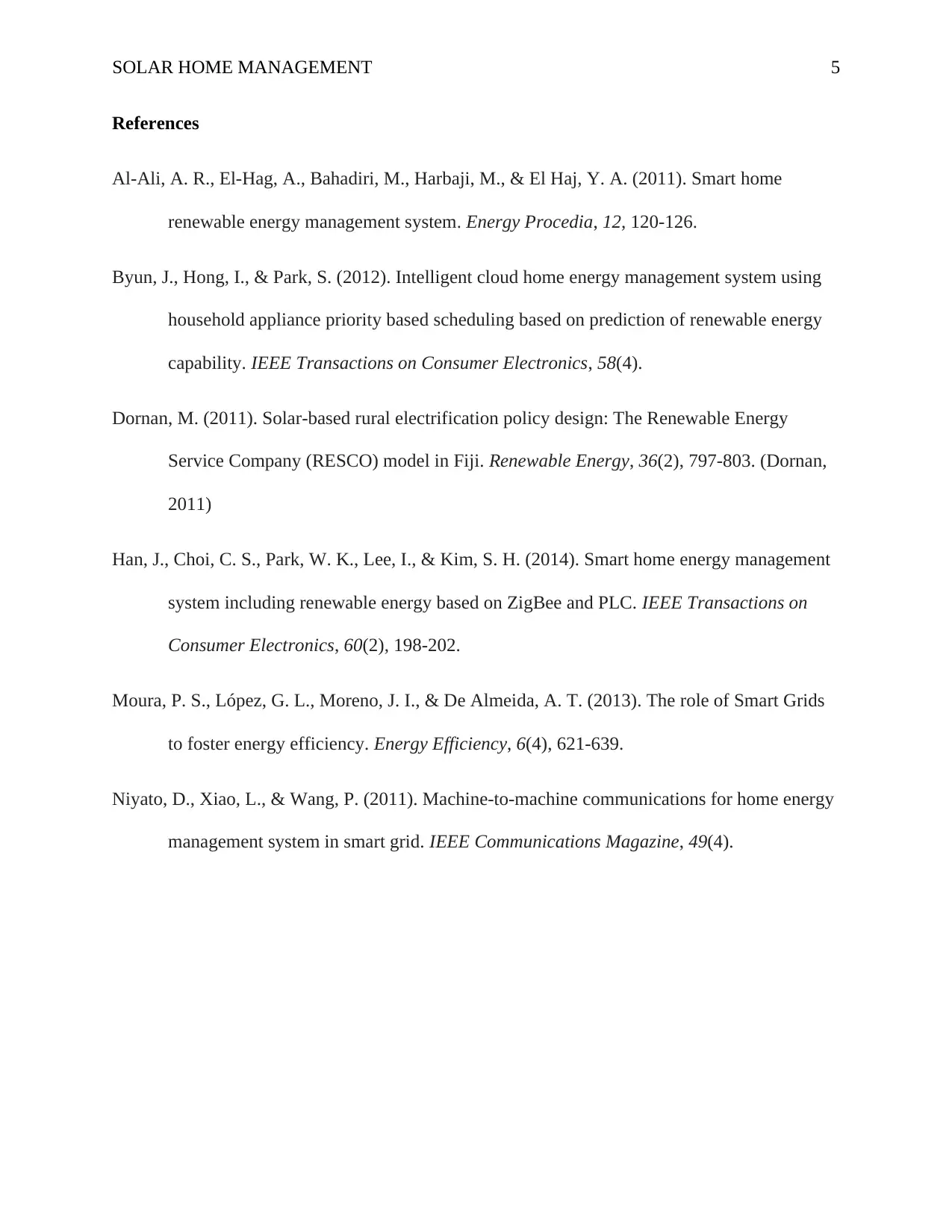Solar Home Management Interface Design: A Comprehensive Analysis
VerifiedAdded on 2020/05/11
|5
|1170
|105
Project
AI Summary
This project report details the design and analysis of a solar home management interface. The interface is designed to efficiently manage energy consumption within a household by incorporating solar power. The design includes various modes such as power off, solar, battery, and grid modes, along with added components and help screens. The system monitors energy flow, provides statistical data on power usage, and alerts users to irregularities. It is designed to be user-friendly, automatic, and cost-effective, addressing the need for reliable and digital energy management. The design draws inspiration from the Sunny Home Manager 2.0, emphasizing automatic operations and efficient solar energy utilization. The project highlights the benefits of the interface in solving power failure problems and providing instrumental data to the user for effective energy management. The help mode guides the user and extends the lifespan of the system.

Running Head: SOLAR HOME MANAGEMENT
Description of the solar home management interface design
Name:
Affiliation:
Date:
Description of the solar home management interface design
Name:
Affiliation:
Date:
Paraphrase This Document
Need a fresh take? Get an instant paraphrase of this document with our AI Paraphraser

SOLAR HOME MANAGEMENT 2
Energy is crucial in every home. Solar energy can be incorporated into homes so that
power cannot be a problem anymore since it is affordable. Before installation, a proper interface
design should be highlighted for the solar home management. The suggested navigation systems
are amongst the best interface designs. The design of the interface was not straightforward since
it addresses various issues aiming at meeting the requirements of customers. The model
consisted of power off screen, solar mode screen, Battery mode, grid mode and added
components mode. There were also help displays ranging from help screen 1 to help screen 6.
All the modes and screens one together from a central point in ensuring that the energy flow is
monitored, saving power automatically and providing efficient use. The main reason as to why I
chose the interface it because it makes intelligent energy management easier and it is cost
effective.
The interface design fully meets the requirement the user. It is because currently, people
want a reliable source of energy which is digital (Han, Choi, Park, Lee & Kim, 2014). A system
which can operate automatically and alert the user in cases of irregularity of energy flow. The
system adequately addresses all the issues since after turning on the condition of the system is
displayed on screens. The system shows the percentage of energy remaining in the battery as
well as the consumed. The system also statistically displays how power has been consumed for
the last three hours. The user can, therefore, plan for the available power and prevent cases of the
blackout. The grid mode represents power supply details from the grid. The system is also user-
friendly since it has help mode which directs the user. Whenever the system is not in the right
condition, it alerts the user through display on the screen using red LED lights. It gives the
direction on what action should be taken. The adopted design covers all the requirement of the
user, therefore, being amongst the best (Byun, Hong & Park, 2012).
Energy is crucial in every home. Solar energy can be incorporated into homes so that
power cannot be a problem anymore since it is affordable. Before installation, a proper interface
design should be highlighted for the solar home management. The suggested navigation systems
are amongst the best interface designs. The design of the interface was not straightforward since
it addresses various issues aiming at meeting the requirements of customers. The model
consisted of power off screen, solar mode screen, Battery mode, grid mode and added
components mode. There were also help displays ranging from help screen 1 to help screen 6.
All the modes and screens one together from a central point in ensuring that the energy flow is
monitored, saving power automatically and providing efficient use. The main reason as to why I
chose the interface it because it makes intelligent energy management easier and it is cost
effective.
The interface design fully meets the requirement the user. It is because currently, people
want a reliable source of energy which is digital (Han, Choi, Park, Lee & Kim, 2014). A system
which can operate automatically and alert the user in cases of irregularity of energy flow. The
system adequately addresses all the issues since after turning on the condition of the system is
displayed on screens. The system shows the percentage of energy remaining in the battery as
well as the consumed. The system also statistically displays how power has been consumed for
the last three hours. The user can, therefore, plan for the available power and prevent cases of the
blackout. The grid mode represents power supply details from the grid. The system is also user-
friendly since it has help mode which directs the user. Whenever the system is not in the right
condition, it alerts the user through display on the screen using red LED lights. It gives the
direction on what action should be taken. The adopted design covers all the requirement of the
user, therefore, being amongst the best (Byun, Hong & Park, 2012).

SOLAR HOME MANAGEMENT 3
The design of the system was influenced by many factors thus adopting the interface. The
fact that many people globally are facing the problem of reliable power especially in developing
countries motivated the adoption of the design. People are spending valuable sources of energy
while we have solar energy which is free. The continuous technology growth also facilitated the
passage of the design interface. With modern technologies, operations are being done
automatically by use of machines (Niyato, Xiao & Wang, 2011). Due to such reasons, a solar
home management system which is automatic was urgently needed by many individuals. The
systems consume less power and manage gadgets using the force. It is cost effective therefore
making it applicable to all people without discrimination. It is easy to operate since it alerts the
user in case of the unexpected condition and saves time.
The development of the interface design heavily relies on the sunny home manager 2.0
interface. The sunny home manager was developed early and highly incorporated modern
technology on its design making it purely automatic (Al-Ali et al, 2011). The sunny home
manager monitors all energy flows in the home and automatically identifies potential savings and
promoting efficient use of solar energy (Moura, Lopez, Moreno & De Almeida, 2013). The
sunny home manager consisting of clear visualization of significant energy flow in the household
provided a trend which was adopted by the interface design since it is based on the same. The
elements of energy flow used in the sunny home manager 2.0 are also applied to the interface.
Most of the setup of the interface was based on that adopted by the sunny home manager 2.0.
The adopted design is the best towards solving the problems of power failure in many
homes. The design interface addresses all concerns relating to the responsible home solar home
manager. The fact that the design is based on technological platform form while making use of
an affordable source of energy makes it solve the problem. The system provides instrumental
The design of the system was influenced by many factors thus adopting the interface. The
fact that many people globally are facing the problem of reliable power especially in developing
countries motivated the adoption of the design. People are spending valuable sources of energy
while we have solar energy which is free. The continuous technology growth also facilitated the
passage of the design interface. With modern technologies, operations are being done
automatically by use of machines (Niyato, Xiao & Wang, 2011). Due to such reasons, a solar
home management system which is automatic was urgently needed by many individuals. The
systems consume less power and manage gadgets using the force. It is cost effective therefore
making it applicable to all people without discrimination. It is easy to operate since it alerts the
user in case of the unexpected condition and saves time.
The development of the interface design heavily relies on the sunny home manager 2.0
interface. The sunny home manager was developed early and highly incorporated modern
technology on its design making it purely automatic (Al-Ali et al, 2011). The sunny home
manager monitors all energy flows in the home and automatically identifies potential savings and
promoting efficient use of solar energy (Moura, Lopez, Moreno & De Almeida, 2013). The
sunny home manager consisting of clear visualization of significant energy flow in the household
provided a trend which was adopted by the interface design since it is based on the same. The
elements of energy flow used in the sunny home manager 2.0 are also applied to the interface.
Most of the setup of the interface was based on that adopted by the sunny home manager 2.0.
The adopted design is the best towards solving the problems of power failure in many
homes. The design interface addresses all concerns relating to the responsible home solar home
manager. The fact that the design is based on technological platform form while making use of
an affordable source of energy makes it solve the problem. The system provides instrumental
⊘ This is a preview!⊘
Do you want full access?
Subscribe today to unlock all pages.

Trusted by 1+ million students worldwide

SOLAR HOME MANAGEMENT 4
data to the user, therefore, enabling him or her to manage the system with fewer inconveniences.
The help mode is beneficial since it guides the user on control the order to ensure that it gives the
best and enlarging its lifespan. The system provides a reliable manager of ensuring that the
available power is managed well is houses. The interface design outstands amongst other models
since it is automatic. Most of the home power manager designs are manual and do not provide
adequate information to the user. A lot of inconveniences is caused to the user. The adopted
interface design is the best since it is designed in a way that it is in apposition to addresses all
user issues.
data to the user, therefore, enabling him or her to manage the system with fewer inconveniences.
The help mode is beneficial since it guides the user on control the order to ensure that it gives the
best and enlarging its lifespan. The system provides a reliable manager of ensuring that the
available power is managed well is houses. The interface design outstands amongst other models
since it is automatic. Most of the home power manager designs are manual and do not provide
adequate information to the user. A lot of inconveniences is caused to the user. The adopted
interface design is the best since it is designed in a way that it is in apposition to addresses all
user issues.
Paraphrase This Document
Need a fresh take? Get an instant paraphrase of this document with our AI Paraphraser

SOLAR HOME MANAGEMENT 5
References
Al-Ali, A. R., El-Hag, A., Bahadiri, M., Harbaji, M., & El Haj, Y. A. (2011). Smart home
renewable energy management system. Energy Procedia, 12, 120-126.
Byun, J., Hong, I., & Park, S. (2012). Intelligent cloud home energy management system using
household appliance priority based scheduling based on prediction of renewable energy
capability. IEEE Transactions on Consumer Electronics, 58(4).
Dornan, M. (2011). Solar-based rural electrification policy design: The Renewable Energy
Service Company (RESCO) model in Fiji. Renewable Energy, 36(2), 797-803. (Dornan,
2011)
Han, J., Choi, C. S., Park, W. K., Lee, I., & Kim, S. H. (2014). Smart home energy management
system including renewable energy based on ZigBee and PLC. IEEE Transactions on
Consumer Electronics, 60(2), 198-202.
Moura, P. S., López, G. L., Moreno, J. I., & De Almeida, A. T. (2013). The role of Smart Grids
to foster energy efficiency. Energy Efficiency, 6(4), 621-639.
Niyato, D., Xiao, L., & Wang, P. (2011). Machine-to-machine communications for home energy
management system in smart grid. IEEE Communications Magazine, 49(4).
References
Al-Ali, A. R., El-Hag, A., Bahadiri, M., Harbaji, M., & El Haj, Y. A. (2011). Smart home
renewable energy management system. Energy Procedia, 12, 120-126.
Byun, J., Hong, I., & Park, S. (2012). Intelligent cloud home energy management system using
household appliance priority based scheduling based on prediction of renewable energy
capability. IEEE Transactions on Consumer Electronics, 58(4).
Dornan, M. (2011). Solar-based rural electrification policy design: The Renewable Energy
Service Company (RESCO) model in Fiji. Renewable Energy, 36(2), 797-803. (Dornan,
2011)
Han, J., Choi, C. S., Park, W. K., Lee, I., & Kim, S. H. (2014). Smart home energy management
system including renewable energy based on ZigBee and PLC. IEEE Transactions on
Consumer Electronics, 60(2), 198-202.
Moura, P. S., López, G. L., Moreno, J. I., & De Almeida, A. T. (2013). The role of Smart Grids
to foster energy efficiency. Energy Efficiency, 6(4), 621-639.
Niyato, D., Xiao, L., & Wang, P. (2011). Machine-to-machine communications for home energy
management system in smart grid. IEEE Communications Magazine, 49(4).
1 out of 5
Related Documents
Your All-in-One AI-Powered Toolkit for Academic Success.
+13062052269
info@desklib.com
Available 24*7 on WhatsApp / Email
![[object Object]](/_next/static/media/star-bottom.7253800d.svg)
Unlock your academic potential
Copyright © 2020–2025 A2Z Services. All Rights Reserved. Developed and managed by ZUCOL.





